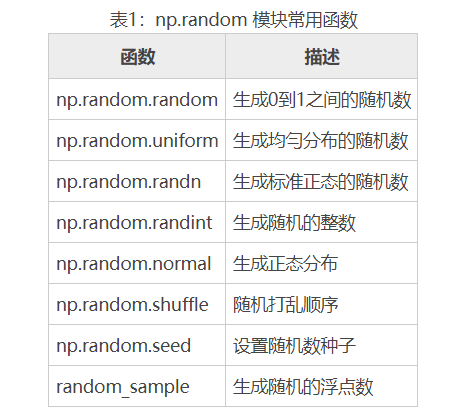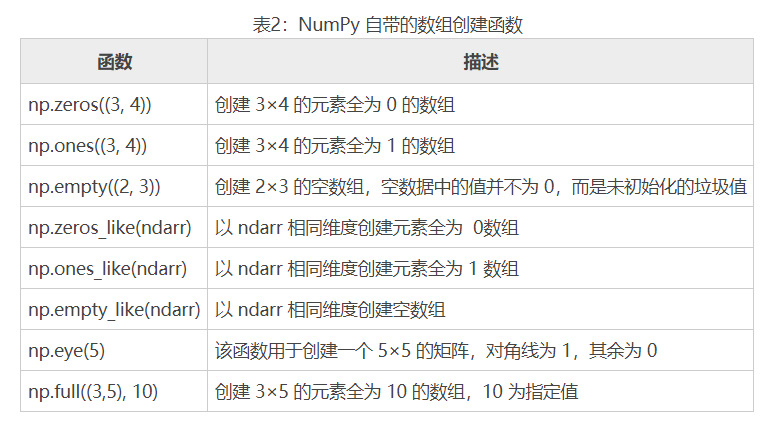numpy 库常见函数的介绍
<1>. numpy创建数组
1. 从已有数据中创建数组
a. 将列表转换成 ndarray:
import numpy as np ls1 = [10, 42, 0, -17, 30] nd1 =np.array(ls1) print(nd1) print(type(nd1))
运行结果:
[ 10 42 0 -17 30] <class 'numpy.ndarray'>
b.嵌套列表可以转换成多维 ndarray:
import numpy as np ls2 = [[8, -2, 0, 34, 7], [6, 7, 8, 9, 10]] nd2 =np.array(ls2) print(nd2) print(type(nd2))
运行结果:
[[ 8 -2 0 34 7] [ 6 7 8 9 10]] <class 'numpy.ndarray'>
2. 利用 random 模块生成数组
几种 np.random 模块中常用的方法,如下表所示。

下面来看一些使用:
import numpy as np
import random
nd3 =np.random.random([4, 3]) #生成4行3列的数组
print(nd3)
print("nd3的形状为:",nd3.shape)
执行结果:
[[0.59115057 0.52022516 0.05992361] [0.5077815 0.81313999 0.70061259] [0.24654561 0.11705634 0.71399966] [0.73964407 0.57138345 0.89284498]] nd3的形状为: (4, 3)
为了每次生成同一份数据,可以指定一个随机种子,使用 shuffle() 函数打乱生成的随机数。
import numpy as np
np.random.seed(123)
nd4 = np.random.randn(4, 3)
print(nd4)
np.random.shuffle(nd4)
print("随机打乱后数据:")
print(nd4)
print(type(nd4))
执行结果:
[[-1.0856306 0.99734545 0.2829785 ] [-1.50629471 -0.57860025 1.65143654] [-2.42667924 -0.42891263 1.26593626] [-0.8667404 -0.67888615 -0.09470897]] 随机打乱后数据: [[-1.50629471 -0.57860025 1.65143654] [-2.42667924 -0.42891263 1.26593626] [-0.8667404 -0.67888615 -0.09470897] [-1.0856306 0.99734545 0.2829785 ]] <class 'numpy.ndarray'>
3. 创建特定形状的多维数组
参数初始化时,有时需要生成一些特殊矩阵,如全是 0 或 1 的数组或矩阵,这时我们可以利用 np.zeros、np.ones、np.diag 来实现,如下表所示。

下面通过几个示例说明:
import numpy as np
# 生成全是 0 的 3x3 矩阵
nd5 =np.zeros([3, 3])
# 生成全是 1 的 3x3 矩阵
nd6 = np.ones([3, 3])
# 生成 4 阶的单位矩阵
nd7 = np.eye(4)
# 生成 4 阶对角矩阵
nd8 = np.diag([1, 8, 3, 10])
print("nd5 =\n", nd5)
print("nd6 =\n", nd6)
print("nd7 =\n", nd7)
print("nd8 =\n", nd8)
运行结果:
nd5 = [[0. 0. 0.] [0. 0. 0.] [0. 0. 0.]] nd6 = [[1. 1. 1.] [1. 1. 1.] [1. 1. 1.]] nd7 = [[1. 0. 0. 0.] [0. 1. 0. 0.] [0. 0. 1. 0.] [0. 0. 0. 1.]] nd8 = [[ 1 0 0 0] [ 0 8 0 0] [ 0 0 3 0] [ 0 0 0 10]]
有时还可能需要把生成的数据暂时保存到文件中,以备后续使用。
import numpy as np
nd9 =np.random.random([3, 5])
np.savetxt(X=nd9, fname='./data.txt')
nd10 = np.loadtxt('./data.txt')
print(nd10)
运行结果:
[[0.1744383 0.15515217 0.74885812 0.57633094 0.06300636] [0.24340527 0.65213913 0.07284238 0.52232677 0.58538849] [0.83611286 0.76508018 0.26018483 0.20485587 0.95476232]]
打开当前目录下的 data.txt 也可以看到格式化的数据。
#图像的手绘效果实现(具体问题+图像处理)
#图像的手绘效果
from PIL import Image
import numpy as np
vec_el = np.pi/2.2
vec_az = np.pi/4.
depth = 10. # (0-100)
im = Image.open('gpnu.jpg').convert('L')
a = np.asarray(im).astype('float')
grad = np.gradient(a)
grad_x, grad_y = grad
grad_x = grad_x*depth/100.
grad_y = grad_y*depth/100.
dx = np.cos(vec_el)*np.cos(vec_az)
dy = np.cos(vec_el)*np.sin(vec_az)
dz = np.sin(vec_el)
A = np.sqrt(grad_x**2 + grad_y**2 + 1.)
uni_x = grad_x/A
uni_y = grad_y/A
uni_z = 1./A
a2 = 255*(dx*uni_x + dy*uni_y + dz*uni_z)
a2 = a2.clip(0,255)
im2 = Image.fromarray(a2.astype('uint8'))
im2.save('gpnuHandDraw.jpg')



